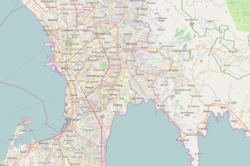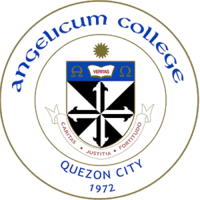UST Angelicum College
The UST Angelicum College is a private Dominican basic and higher education institution run by the Philippine Province of the Order Of Preachers located in Quezon City, Metro Manila, Philippines. It was founded in May 1972 by the Dominican priest Rev. Fr. Rogelio B. Alarcon, OP who became its first rector. UST Angelicum is an official member of the Dominican Network. It attained Level II Primary Accreditation conducted by PAASCU[1]
 | |
Former names | Angelicum School (1972-1996) Angelicum College (1996-2018) |
|---|---|
| Motto | Caritas, Justitia, Fortitudo (Latin) |
Motto in English | Charity, Justice, Fortitude |
| Type | Private, Catholic, Non-Graded Non-profit Coeducational Basic and Higher education institution |
| Established | May 1972 (48 years and 41 days) |
Religious affiliation | Roman Catholic (Dominican) |
Academic affiliations | PAASCU |
| Rector | Rev.Fr. Herminio Dagohoy, OP |
| Director | Fr. Ferdinand Bautista, O.P., Ph.D. (Director for Administrative Affairs) Fr. Noel Kristoffer Castor, O.P. (Director for Financial Affairs) Rev. Fr. Raymund Fernando Jose, O.P. (Director for Religious Affairs) Rosanni M. del Mundo, Ph.D. (Director for Academic Affairs) |
| Students | over 7,000 |
| Address | 12 M.J. Cuenco St. Sta. Mesa Heights , Quezon City , , |
| Campus | Urban |
| Alma Mater song | Angelicum Hymn |
| Colors | Blue and White |
| Nickname | Thomasian-Angelican |
Sporting affiliations | WNCAA, Athletic Association for Private Schools (AAPS) |
| Mascot | Tigers |
| Website | www |
 Location in Metro Manila | |
History
UST Angelicum College started out as an educator's simple dream to break free from the traditional educational system. The educator's name is Fr. Rogelio Alarcon, O.P. When he was an elementary student at the Colegio de San Juan de Letran, he had already begun toying with the idea of a school that would cater to the individual needs of each student and discard the traditional concept of grading.
But it would be years later before his idea would take serious shape. He started to expound on the system without grades, without failures while making comparative studies on the different systems of education while studying at the UST Graduate School.
In 1972, a few months after he was appointed first Provincial of the Philippine Dominican Province, he was able to convince some educators and the Province to put up a non-graded school. It was to be called "Angelicum" after one of the Dominican houses of studies in Rome and its whole existence would be justified by the nature of each individual child. Its philosophy would be "to do what is best for the learners."
In May of 1972, the Ministry of Education and Culture granted permission for the operation of this unique school. It was opened after one month of relentless activity which involved looking for a building, recruiting teachers, enrolling students, getting classroom materials, and arranging for school services.
On July 5, 1972, Angelicum School was born: six classrooms and a small library all housed at the Dominican seminary; 315 young boys under the care of 9 creative, responsible and experienced teachers who were willing to undertake a paradigm shift. It carried out the embodiment of the Dominican ideals of charity, justice, and fortitude. Angelicum became the first non-graded school in the Philippines.
In the second year of its existence, Angelicum's enrollment doubled. The first floor of the St. Dominic Building was finished in time to house the fast growing populace.
In 1974, girls were accepted to meet "the need to normalize the environment." A total of 220 enrolled in the Nursery to YS 5 Levels. Likewise, the St. Martin Building was then ready for the learners.
Angelicum expanded beyond Quezon City. Two branches were established: Angelicum Tehran, Iran and Angelicum Jaro, Iloilo. But due to the religious war in Iran, Angelicum Tehran was closed in 1979.
School directors
In 1978, Rev. Fr. Norberto Castillo, O.P. became the director of the school. The number of students continued to rise and the school gained wider acclaim in the country's educational system. On May 11, 1979, the school library was named Fr. Ed Lumboy Memorial Resource Center in honor of Rev. Fr. Ed Lumboy, one of the school's resident priests who died in a vehicular accident.
Rev. Fr. Hilario Singian, O.P. succeeded Fr. Castillo in 1982. During his term, the St. Vincent Covered Court was completed. After one year, Fr. Singian was replaced by Rev. Fr. Juan Ponce, O.P., who became director for four years. The St. Tomas Building was constructed during this period. In 1987, Rev. Fr. Honorato Castigador, O.P. replaced Fr. Ponce. In 1988, the directorship of the school was given to Rev. Fr. Tamerlane Lana, O.P. The St. Martin Building was renovated in his term. The old cafetorium was expanded and was operational in 1991.
In 1994, Rev. Fr. Rogelio Alarcon, O.P. came back to be the seventh director of Angelicum. Indefatigable in the pursuit of his principles and ideals, he brought back the real essence of the non-graded system. The modular approach was adopted. In 1995, the College Department was opened and the school was renamed Angelicum College in May 1996. In August of the same year, recognition of the Home Study Program was granted. The swimming pool and a new Computer Laboratory were constructed and the Computer Program was extended to the YS 1 to YS 11 learners. The improvement of the football field was also done during this period.
In the year 2000, the new college building was inaugurated in the presence of the former Quezon City Mayor Ishmael Mathay, together with Rev. Fr. Quirico T. Pedregosa Jr., O.P., former Provincial and Chair of the Board of Trustees.
Rev. Fr. Hilario Q. Singian Jr. O.P. was installed as the 8th Rector of the College On October 2002, Rev. Fr. Hilario Q. Singian Jr. O.P. was installed as the 8th Rector of the College. During his term, the third floor of the St. Martin Building was constructed which housed the Home Study Program. Renovation of the St. Vincent Covered Court was also completed.
Fr. Singian ended his term in 2004 and Fr. Herminio Dagohoy, OP succeeded him in June 2004. Improvement of facilities and offices was done like the air-conditioning of all the classrooms at St. Dominic Building and St Thomas Building. Renovations of all offices at the St. Martin Building (octagonal) were also done. He spearheaded the launching of the Solid Waste Management and the rehabilitation of the AC Football Field. In May 2008, Fr. Dagohoy was transferred to UST as one of the administrators of the UST Hospital. Fr. Ferdinand L. Bautista, OP succeeded him and was installed on June 12, 2008 as the 10th Rector and current President of Angelicum College.
Silver anniversary
On its Silver Anniversary in 1998, a musical play KULAYDOSKOP was presented. More than 3,000 learners from the Nursery to YS 11 Levels participated in the play which showcased the country’s heritage.
Special programs
In January 1999, Angelicum College formally launched the Re-entry Education Agenda for the Poor (REAP) Program. The launching ceremony was attended by no less than the President of the Philippines at that time, His Excellency President Joseph E. Estrada.
Integration with University of Santo Tomas

In academic year 2018-19, Angelicum College was renamed University of Santo Tomas – Angelicum College as per a memorandum of agreement signed on June 29, 2017. The renaming was part of plans to oversee and integrate with other Dominican educational institutions in the Philippines.[2]
The existing Board of Trustees of Angelicum was dissolved and a new one was formed composed of 12 members, 9 from UST Manila and 3 from Angelicum College but retained its independence in handling its own administrative and financial affairs. UST Rector Fr. Herminio Dagohoy, O.P. became Chief Executive Officer and College Rector while former Angelicum College Rector Fr. Ferdinand Bautista, O.P. became Chief Operating Officer.[3] As part of the integration process, Rev. Fr. Herminio Dagohoy, O.P. planned to implement new policies and programs to improve Angelicum College's approach to education.[4]
See also
- University of Santo Tomas
- University of Santo Tomas - Legazpi
References
- PAASCU http://www.paascu. org.ph/resources-dir8%20a-b%20angelicum.htm Archived October 26, 2009, at the Wayback Machine
- "Angelicum College in QC officially under UST - The Varsitarian". varsitarian.net.
- "UST, Angelicum QC formalize integration - University of Santo Tomas". www.ust.edu.ph.
- "Level up na! UST takes over Angelicum College". Politiko. July 8, 2017. Retrieved July 2, 2020.
External links
- Angelicum School official website